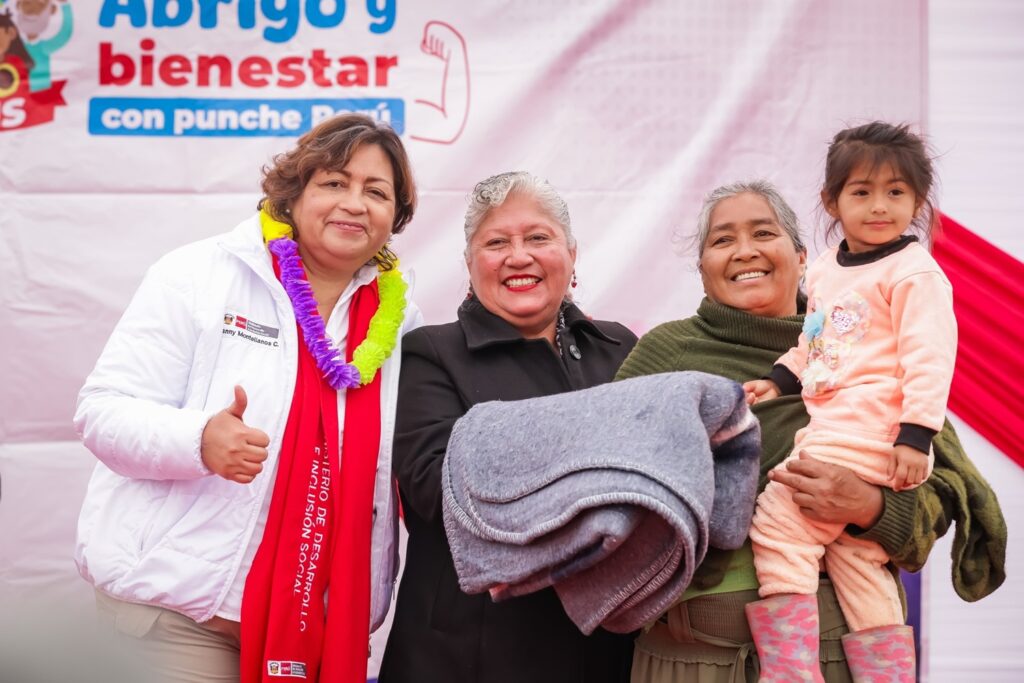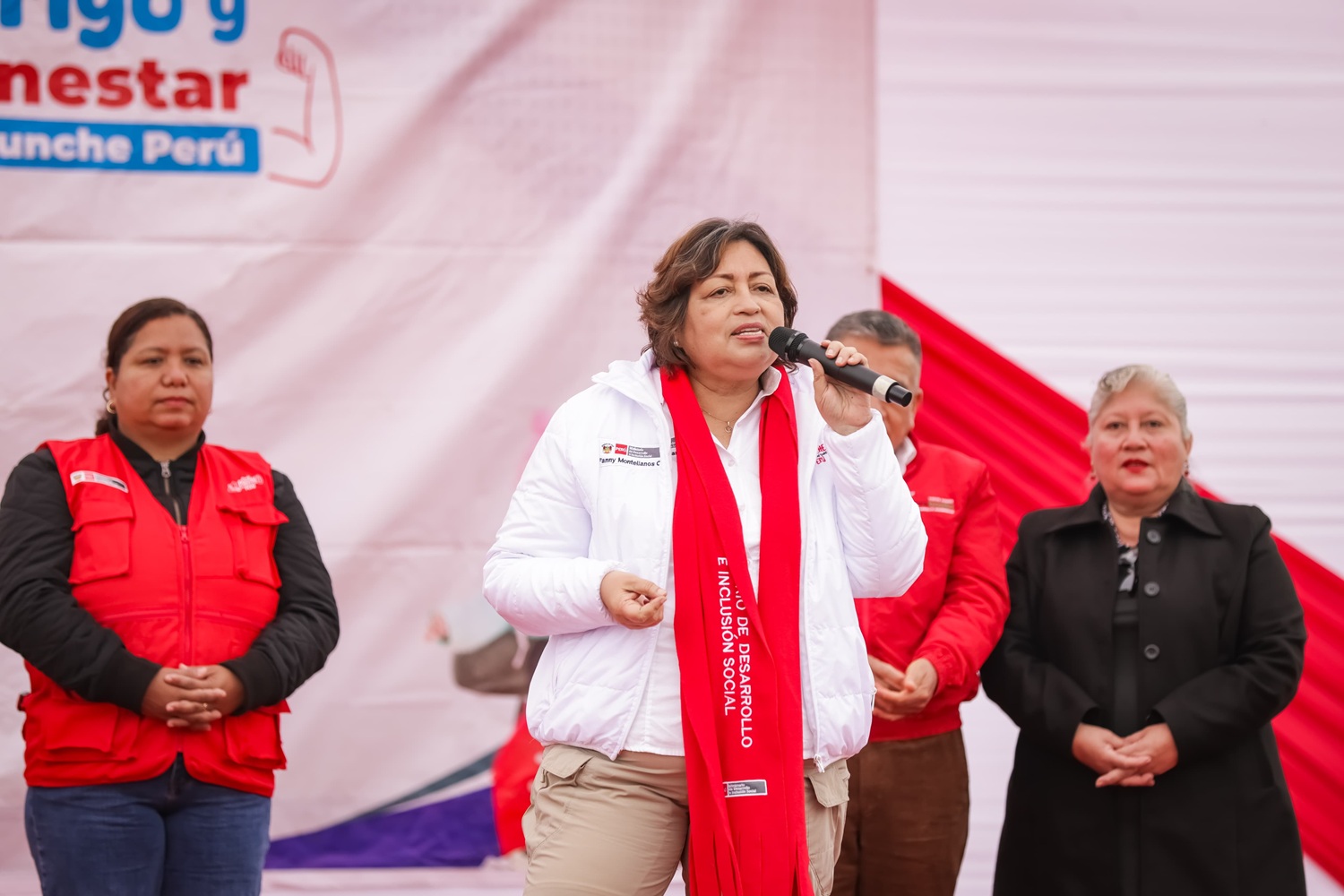Agencia Peruana de Noticias PRENSAPERU.PE https://prensaperu.pe/ Twitter: @prensaperupe El Ministerio de Desarrollo e Inclusión Social (MIDIS) anuncia la culminación de la octava y última edición de la Intervención Multisectorial “Abrigo y Bienestar con Punche Perú”, una iniciativa estratégica diseñada para mitigar el impacto de las bajas temperaturas en poblaciones vulnerables. Esta fase final, llevada a cabo en el Estadio Lolo Fernández de Carabayllo, consolida un esfuerzo gubernamental que ha logrado beneficiar a cerca de 42,000 ciudadanos en situación de pobreza y extrema pobreza a lo largo del año 2025, demostrando la eficacia de la articulación interinstitucional en la política social.
Bajo la dirección de la Ministra Fanny Montellanos, esta serie de intervenciones ha representado un modelo de gobernanza integrada, movilizando recursos y servicios de diversas carteras ministeriales, así como de entidades clave como el Instituto Nacional de Defensa Civil (INDECI) y la Sociedad Nacional de Pesquería. El objetivo primordial ha sido fortalecer las capacidades de prevención y protección de las comunidades frente a los desafíos climáticos, garantizando el acceso a servicios esenciales y promoviendo la resiliencia comunitaria.
Desde su lanzamiento en junio de 2025, las intervenciones multisectoriales han desplegado una amplia gama de atenciones en distritos de alta vulnerabilidad como Villa María del Triunfo, San Juan de Miraflores, Ventanilla, Puente Piedra, San Juan de Lurigancho, El Agustino, Lurigancho–Chosica y, finalmente, Carabayllo. La cifra de 42,000 atenciones directas subraya el alcance y la pertinencia de esta política pública focalizada, que ha respondido de manera proactiva a las necesidades más apremiantes de la ciudadanía.
La Ministra Montellanos enfatizó la imperativa necesidad de una acción coordinada para el desarrollo y la inclusión social. “El progreso no se logra de forma aislada. La colaboración interinstitucional es el pilar de nuestra estrategia, permitiendo que la presencia del Estado sea integral y efectiva en el territorio. Esta sinergia es fundamental para construir un tejido social más fuerte y equitativo”, afirmó. Asimismo, destacó la directriz presidencial de mantener una gestión de proximidad: “Es una instrucción clara de la Presidenta Dina Boluarte: ‘ministros, bajen a la cancha’. Y aquí estamos, en el corazón de las comunidades, atendiendo sus demandas”.
La intervención en Carabayllo, distrito al que el Estado ha destinado una inversión superior a los S/21 millones a través de programas sociales, incluyó la distribución de frazadas para la protección térmica y tres toneladas de pescado, contribuyendo significativamente a la seguridad alimentaria y nutricional de los asistentes. La Ministra estuvo acompañada por el alcalde distrital de Carabayllo, Pablo Mendoza, así como por directores de programas sociales, funcionarios del MIDIS y representantes de los aliados estratégicos, consolidando el compromiso conjunto.
En una actividad previa, la Ministra Montellanos y el alcalde Mendoza visitaron el Comedor Popular Bello Horizonte, un referente de asistencia social con 40 años de trayectoria en Carabayllo, que atiende a cerca de 100 usuarios vulnerables. Durante esta visita, la titular del MIDIS anunció la inminente creación del Programa de Alimentación Comunitaria, una iniciativa de gran envergadura anunciada por la Presidenta Boluarte el 28 de julio, que busca institucionalizar y fortalecer el apoyo a estas organizaciones comunitarias, reafirmando el compromiso del gobierno con la alimentación digna y la sostenibilidad de los servicios sociales.
CONCLUSIONES Y OPCIONES DEL TEMA
1.- Eficacia de la Articulación Multisectorial en Políticas de Protección Social.
La serie de intervenciones “Abrigo y Bienestar con Punche Perú” demuestra que la coordinación efectiva entre diversas entidades gubernamentales y el sector privado es crucial para la implementación exitosa de políticas de protección social. Este modelo permite una respuesta integral y optimizada a las necesidades de las poblaciones vulnerables, trascendiendo la capacidad de acción de una sola institución y maximizando el impacto de la inversión social. Es un paradigma para futuras estrategias de intervención.
2.- Fortalecimiento de la Gobernanza de Proximidad y la Resiliencia Comunitaria.
La directriz de “bajar a la cancha” y la interacción directa con las comunidades, evidenciada por la visita a comedores populares y la participación de autoridades locales, subraya la importancia de una gobernanza de proximidad. Este enfoque no solo garantiza que la ayuda llegue a quienes más la necesitan, sino que también fomenta la participación ciudadana y fortalece la capacidad de las comunidades para gestionar sus propios riesgos y desarrollar resiliencia frente a adversidades socioeconómicas y climáticas.
3.- Transición de la Asistencia Urgente a la Sostenibilidad de la Seguridad Alimentaria.
Si bien la entrega de frazadas y alimentos como pescado responde a una necesidad inmediata de abrigo y nutrición, el anuncio del Programa de Alimentación Comunitaria marca una evolución hacia una estrategia de seguridad alimentaria más estructurada y sostenible. Esta transición refleja un compromiso a largo plazo del Estado para no solo paliar las carencias temporales, sino también para institucionalizar mecanismos de apoyo que garanticen el derecho a la alimentación y fortalezcan las redes comunitarias de asistencia de manera permanente.
Fuente: Agencia Peruana de Noticias PRENSAPERU.PE https://prensaperu.pe/ Twitter: @prensaperupe

English Translation
MIDIS in Carabayllo: Epicenter of the closure of “Shelter and Well-being,” receives investment of S/21 million and multisector support.
Peruvian News Agency PRENSAPERU.PE https://prensaperu.pe/ Twitter: @prensaperupe The Ministry of Development and Social Inclusion (MIDIS) announces the completion of the eighth and final edition of the Multisectoral Intervention “Shelter and Well-being with Punche Perú,” a strategic initiative designed to mitigate the impact of low temperatures on vulnerable populations. This final phase, carried out at the Lolo Fernández Stadium in Carabayllo, consolidates a government effort that has benefited nearly 42,000 citizens living in poverty and extreme poverty throughout 2025, demonstrating the effectiveness of inter-institutional coordination in social policy.
Under the leadership of Minister Fanny Montellanos, this series of interventions has represented a model of integrated governance, mobilizing resources and services from various ministerial departments, as well as key entities such as the National Civil Defense Institute (INDECI) and the National Fisheries Society. The primary objective has been to strengthen communities’ prevention and protection capacities in the face of climate challenges, guaranteeing access to essential services, and promoting community resilience.
Since its launch in June 2025, multisectoral interventions have provided a wide range of services in highly vulnerable districts such as Villa María del Triunfo, San Juan de Miraflores, Ventanilla, Puente Piedra, San Juan de Lurigancho, El Agustino, Lurigancho–Chosica, and finally, Carabayllo. The figure of 42,000 direct services underscores the scope and relevance of this targeted public policy, which has proactively responded to citizens’ most pressing needs.
Minister Montellanos emphasized the imperative need for coordinated action for development and social inclusion. “Progress is not achieved in isolation. Inter-institutional collaboration is the cornerstone of our strategy, enabling a comprehensive and effective state presence in the region. This synergy is essential for building a stronger and more equitable social fabric,” she stated. She also highlighted the presidential directive to maintain a close-knit approach: “It’s a clear instruction from President Dina Boluarte: ‘Ministers, get down on the field.’ And here we are, in the heart of the communities, addressing their demands.”
The intervention in Carabayllo, a district to which the State has allocated an investment of more than S/21 million through social programs, included the distribution of thermal blankets and three tons of fish, significantly contributing to the food and nutritional security of those attending. The Minister was accompanied by the district mayor of Carabayllo, Pablo Mendoza, as well as social program directors, MIDIS officials, and representatives of strategic allies, consolidating their joint commitment.
In a prior activity, Minister Montellanos and Mayor Mendoza visited the Bello Horizonte Soup Kitchen, a benchmark social assistance center with 40 years of experience in Carabayllo, which serves nearly 100 vulnerable users. During this visit, the head of MIDIS announced the imminent creation of the Community Food Program, a large-scale initiative announced by President Boluarte on July 28. This program seeks to institutionalize and strengthen support for these community organizations, reaffirming the government’s commitment to providing decent food and the sustainability of social services.
CONCLUSIONS AND OPTIONS ON THE TOPIC
1.- Effectiveness of Multisectoral Coordination in Social Protection Policies.
The “Shelter and Well-being with Punche Perú” series of interventions demonstrates that effective coordination between various government entities and the private sector is crucial for the successful implementation of social protection policies. This model allows for a comprehensive and optimized response to the needs of vulnerable populations, transcending the capacity of a single institution and maximizing the impact of social investment. It is a paradigm for future intervention strategies.
2.- Strengthening Local Governance and Community Resilience.
The “getting down to the field” approach and direct interaction with communities, evidenced by visits to soup kitchens and the participation of local authorities, underscore the importance of local governance. This approach not only ensures that aid reaches those most in need, but also fosters citizen participation and strengthens communities’ capacity to manage their own risks and build resilience to socioeconomic and climate-related adversities.
3.- Transition from Emergency Assistance to Sustainable Food Security.
While the distribution of blankets and food items such as fish responds to an immediate need for shelter and nutrition, the announcement of the Community Food Program marks an evolution toward a more structured and sustainable food security strategy. This transition reflects the State’s long-term commitment not only to alleviate temporary shortages but also to institutionalize support mechanisms that guarantee the right to food and permanently strengthen community assistance networks.
Source: Peruvian News Agency PRENSAPERU.PE https://prensaperu.pe/ Twitter: @prensaperupe
